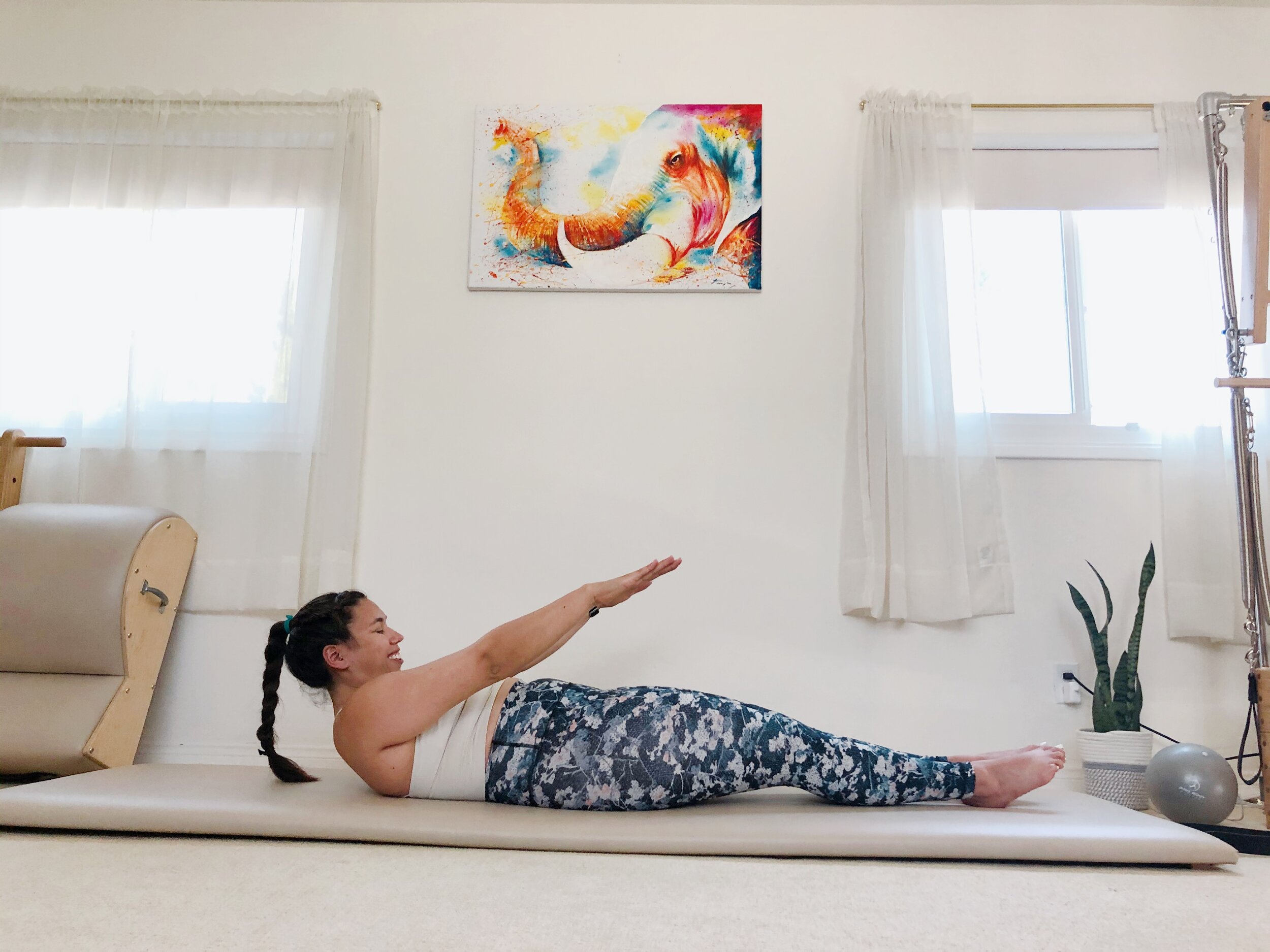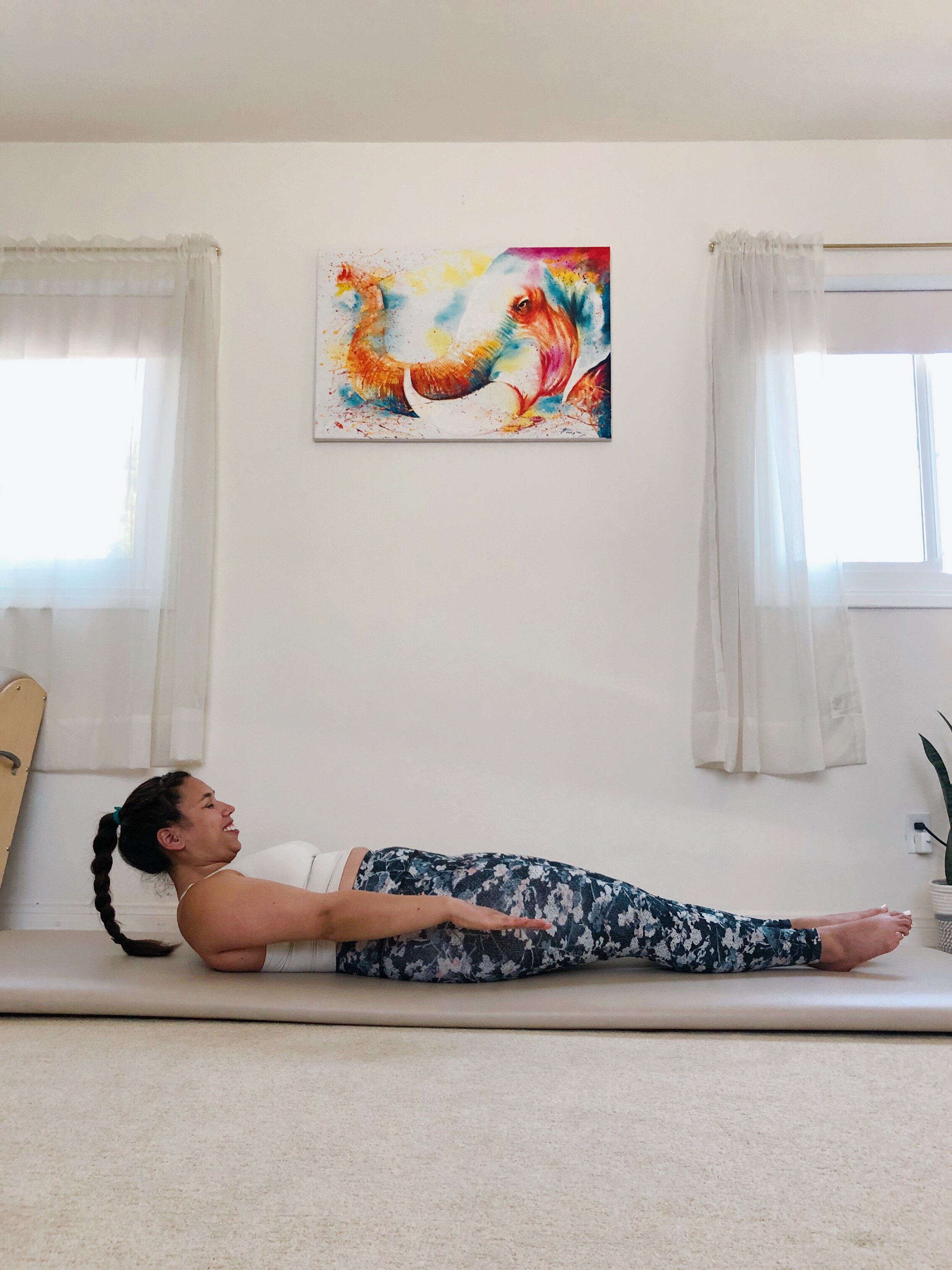Why do we do the hundred in Pilates?
The hundred is an exercise that you will see in Pilates in basically everywhere. I don't think that you'll be able to go to a Pilates class without seeing it because it's basically a quintessential Pilates exercise.
What does this exercise do, besides look silly if it’s your first time ever seeing it? It will warm up your entire body, it will coordinate your movement with your respiratory system (which you're going to have to be using throughout the whole workout routine) and also it teaches you about full body integration.
Breathing Benefits
Ideally, you are breathing through your nose with your inhales and your exhales. We want to focus on nasal breathing because breathing through your nose will tap into your body’s natural filtration system. It will help to filter the air that goes into your lungs, which then goes into you blood and to the muscles you will be working. Secondly, when you nasal breath, it will help to improve your posture. As you start to expand through your chest you stretch it along with the pectoral muscles. It also will expand through the rib cage which helps to open and loosen your upper back muscles. Nasal breathing is also better for your dental hygiene, because like I mentioned, your nose is a natural filtration system. So, it is going to naturally filter some of the natural pollutants that are in the air.
Mechanical benefits
It is a whole body exercise. The hundreds, is basically meant to destabilize your body as your arms are pumping vigorously and your core is trying to stabilize you.
Your legs are trying to be still as your arms are pumping.
Your head and neck are trying to stay still as your arms are pumping,.
Your trunk is trying to stay stable as your arms are pumping.
Your arms are basically trying to bully you around and knock you off your balance as they pump.
Why else do we pump the arms? We're starting to get the blood flow going. So think that the more vigorously you pump, the more you're gonna get the heart rate up, the more the heart rate gets up, the more that it can pump blood through your body, and that's how we get to warm up your muscles.
But how do we pump are arms without moving anything else?
The pumping comes from our back and not actually from our arms. I know, a little bit confusing. A great exercise if you do experience tension in your neck or shoulders on a day to day basis because it means you need to move more from your back. That’s a topic for another blog post though. This exercise will be challenging initially for coordination. A lot of times I see more people pumping with their hands, and you want to pump with straight wrists, straight elbows and from your shoulder blade complex.
How you actually do the exercise?
Set up: Lay down on your back. If you've never done Pilates before and you're going to be doing hundreds for your first time, either a knees bent with the feet on the floor or in a straight out position. You'll know right away which one feels more comfortable to you. Sometimes when people are with their legs straight, their head tilts slightly backwards so you’ll want to make sure you're looking up at the sky/ceiling. If you feel like your lower back is arching and splaying your guts up to the ceiling that’s when you would know that you would be choosing a bent knee position.
We typically start with our hands up to the sky so that we can get integrated into our back. Sometimes the shoulders will start a little bit more rounded forward. We want our shoulders into our back here so think about trying to get your collarbone line long like someone is pulling both ends of your shirt apart.
Entering Position: Straight arms press down, upper body lifts up, and the hands are about hip level reaching across the room past your feet.
Start your pumps taking the hands from about hip level to knee height. The challenge here for beginners is to do the breathing. Try to take your biggest inhale at the same time that you're pumping your arms and then let out the biggest exhale. Aim for deep long breaths instead of short choppy breaths.. You will see a little bit of belly rising but we really want to try to get a little bit more air into our side ribs here for 3D breathing.
I've talked a little bit about that before and I encourage you to read my blog or watch my YouTube Video on it if you haven’t already. Reader’s Digest synopsis: we want to see the chest and the belly rise and fall at the same time, feel your rib cage expand from side to side, you feel a little bit of heaviness into the back of your bottom ribs.
There is also the option to just focus on the breathing with the head down while pumping the arms. This might be a better option if you start to feel tension in the front or back of your neck. You're still going to get benefits of being connected into the lats, find the diaphragmatic/3D breathing, filtering the air through the nose, and working on the postural muscles. Remember the pumping is also acting as a pump for our blood to get the oxygenated blood through our body.
Another variation. If your legs are going to be straight, I would really recommend that the head, neck and shoulders be up and lifted. For this option there would be a point where you are so connected to your core that your legs could just float up from the strength in your lower belly. The legs being lifted add a longer lever for our core to try to stabilize with making it a little more challenging.
Why is it even called the hundred?
It's 100 beats/pumps. So, on top of everything we’ve already covered we're also trying to work on the rhythm of our breathing. Our inhale count (5 beats) matches our exhale(5 beats) making a set of 10 counts, you do it 10 times, making it the hundred.
It's a really great way to work on your increasing your lung capacity which is why I think it is a great exercise for runners and athletes. Also, if you work at a computer or have a tight chest or rounded shoulders this will help to expand your lungs, stretch your pectoral muscles, and your neck.
(Psst. This is one of the reasons why people say Pilates helps you grow taller.)
Check the video below for an audio & real time visual of the concepts in this article. Don’t forget to subscribe to the YouTube channel so you can continue to learn more.
If you still have questions about the Hundred leave it in the comment box below. Also, if you are interested in another deep dive on a Pilates exercise let me know in the comments what exercise(s) you would like me to cover!





